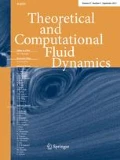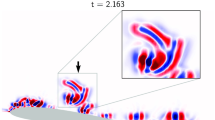Abstract
We present a systematic approach for determining the optimal actuator location for separation control from input–output response data, gathered from numerical simulations or physical experiments. The Eigensystem realization algorithm is used to extract state-space descriptions from the response data associated with a candidate set of actuator locations. These system realizations are then used to determine the actuator location among the set that can drive the system output to an arbitrary value with minimal control effort. The solution of the corresponding minimum energy optimal control problem is evaluated by computing the generalized output controllability Gramian. We use the method to analyze high-fidelity numerical simulation data of the lift and separation angle responses to a pulse of localized body-force actuation from six distinct locations on the upper surface of a NACA 65(1)-412 airfoil. We find that the optimal location for controlling lift is different from the optimal location for controlling separation angle. In order to explain the physical mechanisms underlying these differences, we conduct controllability analyses of the flowfield by leveraging the dynamic mode decomposition with control algorithm. These modal analyses of flowfield response data reveal that excitation of coherent structures in the wake benefits lift control, whereas excitation of coherent structures in the shear layer benefits separation angle control.











Similar content being viewed by others
Notes
Although finite time-horizons can be considered, we choose to focus on the infinite time-horizon case in order to maintain objectivity in the optimality measure; the solution to the finite time-horizon problem is dependent on the final time, which can be undesirable because the final time can always be chosen to influence the outcome of the optimality measure.
Tustin’s approximation allows for conversion between continuous-time and discrete-time representations of a dynamic system. Given the sampling time \(T_s\), the approximation leverages a bilinear Tustin transformation to map between all points in the s-plane and the z-plane:
$$\begin{aligned} z = e^{sT_s} \approx \frac{1+sT_s/2}{1-sT_s/2}. \end{aligned}$$The transformation is sometimes used to relate optimal control problems formulated in continuous-time to counterparts in discrete-time and vice versa.
References
Gad-el-Hak, M.: Flow Control: Passive, Active, and Reactive Flow Management. Cambridge University Press, Cambridge (2000)
Williams, D.R., MacMynowski, D.G.: Brief history of flow control. In: Joslin, R.D., Miller, D.N. (eds.) Fundamentals and Applications of Modern Flow Control, pp. 1–20. American Institute of Aeronautics and Astronautics, Reston (2009)
Cattafesta, L.N., Sheplak, M.: Actuators for active flow control. Annu. Rev. Fluid Mech. 43, 247–272 (2011)
Sosa, R., Artana, G., Moreau, E., Touchard, G.: Stall control at high angle of attack with plasma sheet actuators. Exp. Fluids 42(1), 143–167 (2007)
Little, J., Samimy, M.: High-lift airfoil separation with dielectric barrier discharge plasma actuation. AIAA J. 48(12), 2884–2898 (2010)
Mabe, J., Calkins, F., Wesley, B., Woszidlo, R., Taubert, L., Wygnanski, I.: Single dielectric barrier discharge plasma actuators for improved airfoil performance. J. Aircr. 46(3), 847–855 (2009)
Cerretelli, C., Kirtley, K.: Boundary layer separation control with fluidic oscillators. J. Turbomach. 131(4), 041001 (2009)
Gregory, J., Tomac, M.N.: A review of fluidic oscillator development. In: AIAA Paper, p. 2474 (2013)
Woszidlo, R., Wygnanski, I.: Parameters governing separation control with sweeping jet actuators. In: AIAA Paper p. 3172 (2011)
Seo, J.H., Zhu, C., Mittal, R.: Flow physics and frequency scaling of sweeping jet fluidic oscillators. AIAA J. 56(6), 2208–2219 (2018)
Ostermann, F., Woszidlo, R., Nayeri, C.N., Paschereit, C.O.: The interaction between a spatially oscillating jet emitted by a fluidic oscillator and a crossflow. J. Fluid Mech. 863, 215–241 (2018)
Amitay, M., Smith, B., Glezer, A.: Aerodynamic flow control using synthetic jet technology. In: 36th AIAA Aerospace Sciences Meeting and Exhibit (1998)
Glezer, A., Amitay, M.: Synthetic jets. Annu. Rev. Fluid Mech. 34(1), 503–529 (2002)
Hemati, M., Deem, E., Williams, M., Rowley, C.W., Cattafesta, L.N.: Improving separation control with noise-robust variants of dynamic mode decomposition. In: 54th AIAA Aerospace Sciences Meeting, p. 1103 (2016)
Deem, E., Cattafesta, L., Yao, H., Hemati, M., Zhang, H., Rowley, C.: Experimental implementation of modal approaches for autonomous reattachment of separated flows. In: AIAA Aerospace Sciences Meeting, AIAA Paper, p. 1052 (2018)
Seo, J., Cadieux, F., Mittal, R., Deem, E., Cattafesta, L.: Effect of synthetic jet modulation schemes on the reduction of a laminar separation bubble. Phys. Rev. Fluids 3, 033901 (2018)
Seifert, A., Bachar, T., Koss, D., Shepshelovich, M., Wygnanski, I.: Oscillatory blowing: a tool to delay boundary-layer separation. AIAA J. 31(11), 2052–2060 (1993)
Yarusevych, S., Kawall, J., Sullivan, P.E.: Airfoil performance at low Reynolds numbers in the presence of periodic disturbances. J. Fluids Eng. 128(3), 587–595 (2006)
Postl, D., Balzer, W., Fasel, H.: Control of laminar separation using pulsed vortex generator jets: direct numerical simulations. J. Fluid Mech. 676, 81–109 (2011)
Marxen, O., Kotapati, R., Mittal, R., Zaki, T.: Stability analysis of separated flows subject to control by zero-net-mass-flux jet. Phys. Fluids 27(2), 024107 (2015)
Yarusevych, S., Kotsonis, M.: Steady and transient response of a laminar separation bubble to controlled disturbances. J. Fluid Mech. 813, 955–990 (2017)
Raju, R., Mittal, R., Cattafesta, L.: Dynamics of airfoil separation control using zero-net mass-flux forcing. AIAA J. 46(12), 3103–3115 (2008)
Mittal, R., Kotapati, R.B.: Resonant mode interaction in a canonical separated flow. In: IUTAM Symposium on Laminar-Turbulent Transition. Springer, Berlin, pp. 341–348 (2006)
Mittal, R., Kotapati, R., Cattafesta, L.: Numerical study of resonant interactions and flow control in a canonical separated flow. In: 43rd AIAA aerospace sciences meeting and exhibit, p. 1261. AIAA (2005)
Yeh, C.-A., Taira, K.: Resolvent-analysis-based design of airfoil separation control. J. Fluid Mech. 867, 572–610 (2019)
Taira, K., Hemati, M.S., Brunton, S.L., Sun, Y., Duraisamy, K., Bagheri, S., Dawson, S.T.M., Yeh, C.-A.: Modal Analysis of Fluid Flows: Applications and Outlook. (2019). arXiv:1903.05750
Deem, E.A., Cattafesta, L.N., Zhang, H., Rowley, C.W., Hemati, M., Cadieux, F., Mittal, R.: Identifying dynamic modes of separated flow subject to ZNMF-based control from surface pressure measurements. In: 47th AIAA Fluid Dynamics Conference, AIAA Paper, p. 3309 (2017)
Hemati, M.S., Rowley, C.W., Deem, E.A., Cattafesta, L.N.: De-biasing the dynamic mode decomposition for applied Koopman spectral analysis of noisy datasets. Theoret. Comput. Fluid Dyn. 31(4), 349–368 (2017)
Chen, K.K., Rowley, C.W.: H2 optimal actuator and sensor placement in the linearised complex Ginzburg–Landau system. J. Fluid Mech. 681, 241–260 (2011)
Chanekar, P.V., Chopra, N., Azarm, S.: Optimal actuator placement for linear systems with limited number of actuators. In: American Control Conference (ACC), pp. 334–339. IEEE (2017)
Manohar, K., Brunton, B., Kutz, J., Brunton, S.: Data-driven sparse sensor placement for reconstruction: demonstrating the benefits of exploiting known patterns. IEEE Control Syst. Mag. 38(3), 63–86 (2018)
Clark, E., Askham, T., Brunton, S.L., Kutz, J.N.: Greedy Sensor Placement with Cost Constraints. (2018). arXiv:1805.03717
Saito, Y., Nonomura, T., Yamada, K., Asai, K., Sasaki, Y., Tsubakino, D.: Determinant-Based Fast Greedy Sensor Selection Algorithm. (2019). arXiv preprint arXiv:1911.08757
Yamada, K., Saito, Y., Nankai, K., Nonomura, T., Asai, K., Tsubakino, D.: Fast Greedy Optimization of Sensor Selection in Measurement with Correlated Noise. (2019). arXiv preprint arXiv:1912.01776
Yao, H., Hemati, M.: Advances in output feedback control of transient energy growth in a linearized channel flow. In: AIAA Paper p. 0882 (2019)
Jeong, P.: Synthetic jet flow control of two-dimensional NACA 65(1)-412 airfoil flow with finite-time Lyapunov exponent analysis of Lagrangian coherent structures. Master’s thesis, San Diego State University, San Diego, CA (2016)
Torres, R.: Experimental study of the use of synthetic jet actuators for flight control. Master’s thesis, San Diego State University, San Diego, CA (2014)
Simpson, R.L.: Junction flows. Annu. Rev. Fluid Mech. 33, 415–433 (2001)
Haller, G.: Exact theory of unsteady separation for two-dimensional flows. J. Fluid Mech. 512, 257–311 (2004)
Klose, B.F., Serra, M., Jacobs, G.B.: The Kinematics of Lagrangian Flow Separation in External Aerodynamics. (2019). arXiv:1909.04129
Kamphuis, M., Jacobs, G.B., Chen, K., Spedding, G., Hoeijmakers, H.: Actuation, pulse, effects, its, on separated Lagrangian coherent structures for flow over a cambered airfoil. In: AIAA Aerospace Sciences Meeting, p. 2255. AIAA (2018)
Juang, J.-N., Pappa, R.S.: An eigensystem realization algorithm for modal parameter identification and model reduction. J. Guid. 8(5), 620–627 (1985)
Flinois, T.L.B., Morgans, A.S.: Feedback control of unstable flows: a direct modelling approach using the Eigensystem Realisation Algorithm. J. Fluid Mech. 793, 41–78 (2016)
Ma, Z., Ahuja, S., Rowley, C.W.: Reduced-order models for control of fluids using the Eigensystem Realization Algorithm. Theoret. Comput. Fluid Dyn. 25, 233–247 (2011)
Toscano, R.: Structured Controllers for Uncertain Systems: A Stochastic Optimization Approach. Springer, London (2013)
Kreindler, E., Sarachik, P.: On the concepts of controllability and observability of linear systems. IEEE Trans. Autom. Control 9(2), 129–136 (1964)
Skogestad, S., Postlethwaite, I.: Multivariable Feedback Control: Analysis and Design, vol. 2. Wiley, New York (2007)
Zhou, K., Salomon, G., Wu, E.: Balanced realization and model reduction for unstable systems. Int. J. Robust Nonlinear Control 9, 183–198 (1999)
Åström, K.J., Wittenmark, B.: Computer-Controlled Systems: Theory and Design. Prentice-Hall, Upper Saddle River (1997)
Vicario, F.: OKID as a General Approach to Linear and Bilinear System Identification. Columbia University, New York City (2014)
Juang, J.-N., Phan, M.Q., Horta, L.G., Longman, R.W.: Identification of observer/Kalman Filter markov parameters: theory and experiments. J. Guid. Control Dyn. 16(2), 320–329 (1993)
Nelson, D.A., Jacobs, G.B., Kopriva, D.A.: Effect of boundary representation on viscous, separated flows in a discontinuous-Galerkin Navier–Stokes solver. Theoret. Comput. Fluid Dyn. 30(4), 363–385 (2016)
Kopriva, D.A.: Implementing Spectral Methods for Partial Differential Equations: Algorithms for Scientists and Engineers. Springer, Berlin (2009)
Jacobs, G.B., Kopriva, D., Mashayek, F.: A comparison of outflow boundary conditions for the multidomain staggered-grid spectral method. Numer. Heat Transf. B Fundam. 44(3), 225–251 (2003)
Suzuki, T., Colonius, T., Pirozzoli, S.: Vortex shedding in a two-dimensional diffuser: theory and simulation of separation control by periodic mass injection. J. Fluid Mech. 520, 187–213 (2004)
Schmid, P.J.: Dynamic mode decomposition of numerical and experimental data. J. Fluid Mech. 656, 5–28 (2010)
Rowley, C.W., Mezić, I., Bagheri, S., Schlatter, P., Henningson, D.S.: Spectral analysis of nonlinear flows. J. Fluid Mech. 641, 115–127 (2009)
Tu, J., Rowley, C., Luchtenberg, D., Brunton, S., Kutz, J.: On dynamic mode decomposition: theory and algorithms. J. Comput. Dyn. 1, 391–421 (2014)
Proctor, J.L., Brunton, S.L., Kutz, J.N.: Dynamic mode decomposition with control. SIAM J. Appl. Dyn. Syst. 15(1), 142–161 (2016)
Dawson, S., Hemati, M., Williams, M., Rowley, C.: Characterizing and correcting for the effect of sensor noise in the dynamic mode decomposition. Exp. Fluids 57, 42 (2016)
Askham, T., Kutz, J.: Variable projection methods for an optimized dynamic mode decomposition. SIAM J. Appl. Dyn. Syst. 17(1), 380–416 (2018)
Nonomura, T., Shibata, H., Takaki, R.: Dynamic mode decomposition using a Kalman filter for parameter estimation. AIP Adv. 8(10), 105106 (2018)
Zhang, W., Wei, M.: Model order reduction using DMD modes and adjoint DMD modes. In: AIAA Paper, p. 3482 (2017)
Brogan, W.L.: Modern Control Theory. Prentice-Hall, Englewood Cliffs (1974)
Hamdan, A., Nayfeh, A.: Measures of modal controllability and observability for first-and second-order linear systems. J. Guid. Control Dyn. 12(3), 421–428 (1989)
Acknowledgements
This material is based upon work supported by the Air Force Office of Scientific Research under awards FA9550-16-1-0392, FA9550-17-1-0252, and FA9550-19-1-0034 monitored by Drs. Douglas R. Smith and Gregg Abate. The authors thank Dr. Kevin K. Chen for initial discussions related to optimal actuator selection.
Author information
Authors and Affiliations
Corresponding author
Additional information
Communicated by Tim Colonius.
Publisher's Note
Springer Nature remains neutral with regard to jurisdictional claims in published maps and institutional affiliations.
Rights and permissions
About this article
Cite this article
Bhattacharjee, D., Klose, B., Jacobs, G.B. et al. Data-driven selection of actuators for optimal control of airfoil separation. Theor. Comput. Fluid Dyn. 34, 557–575 (2020). https://doi.org/10.1007/s00162-020-00526-y
Received:
Accepted:
Published:
Issue Date:
DOI: https://doi.org/10.1007/s00162-020-00526-y




